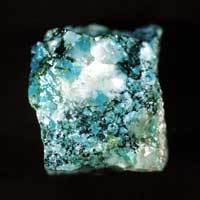MONTHLY NEWS Two Young Brothers Find Gold |
Wakayama Prefecture lies just to the south of Osaka. Two years ago in Wakayama City, two brothers, one now in the first year of middle school and the other in the fourth grade of elementary school, discovered gold in the mountains. The brothers, Toshiki and Yoshitomi Matsumoto, were working on an independent-study project during their summer vacation and had gone out with their father to look for and collect minerals. During their search they discovered some stones that had been chipped away from a rock bed. Some of the stones had a sort of gold and bright blue material attached to them. When he saw these rocks, Toshiki (the older brother) thought that they might be gold, and after inspection by an environmental consulting firm in Tokyo, the family learned that the gold-colored substance on the rocks was indeed gold. Yoshitomi (the younger brother) says, "We were surprised when we found out it was gold."
The largest flecks of gold were very tiny - measuring about 1.5 square millimeters. One ton of the mineral ore the boys found contains about 534 grams of gold. Usually, one ton of rock contains only about 50 grams of gold, so the location that the boys discovered is part of a high-quality gold vein. According to experts, however, there is not enough gold buried there to develop this area into a gold mine because of the condition of the rock strata and other factors.
The brothers discovered not only gold; the bluish substance that was on the rocks turned out to be teineite, a mineral previously only found in two places in Japan - Hokkaido and Shizuoka Prefecture. Teineite is an extremely rare mineral and was first discovered only in 1936 in the Hokkaido town of Teine, from which it takes its name. The place where the boys discovered the minerals is on the southern side of a major fault line running from the center of the Japanese archipelago to the island of Kyushu. The intense heat and pressure there have resulted in a layer where it is possible to find rare minerals like gold. Experts have praised the brothers' discovery and said it is possible that the rock strata contain other rare minerals. Because the area might be flooded with visitors if word were to get out, the boys kept their discovery a secret for two years. The National Science Museum and other academic groups planned to announce the discovery in October, though, and the local board of education in Wakayama had begun considering how to preserve the site. Taking advantage of this opportunity, the boys finally broke their silence and presented the results of their independent-study project to their schools in September. The older brother, said, "Everyone at school was really excited about the discovery. I hope that area can be preserved so that a lot of people can see it." Photos: (Top) An example of the rock the boys found; (middle) The brothers with their father: (bottom) A speck of gold shines out from a piece of rock. (Haruhito Matsumoto) |

|


